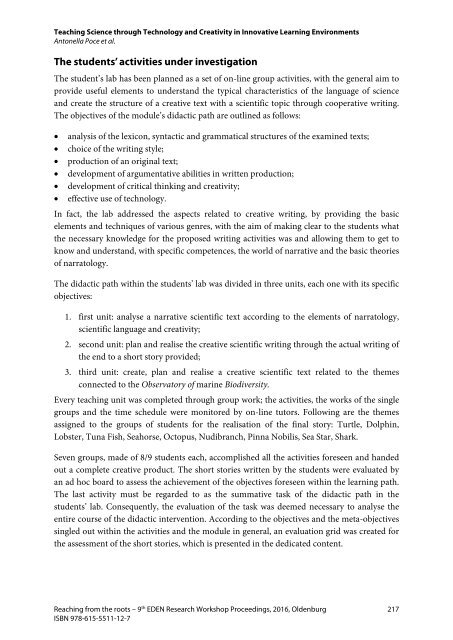Forging new pathways of research and innovation in open and distance learning
RW_2016_Oldenburg_Proceedings
RW_2016_Oldenburg_Proceedings
You also want an ePaper? Increase the reach of your titles
YUMPU automatically turns print PDFs into web optimized ePapers that Google loves.
Teach<strong>in</strong>g Science through Technology <strong>and</strong> Creativity <strong>in</strong> Innovative Learn<strong>in</strong>g Environments<br />
Antonella Poce et al.<br />
The students’ activities under <strong>in</strong>vestigation<br />
The student’s lab has been planned as a set <strong>of</strong> on-l<strong>in</strong>e group activities, with the general aim to<br />
provide useful elements to underst<strong>and</strong> the typical characteristics <strong>of</strong> the language <strong>of</strong> science<br />
<strong>and</strong> create the structure <strong>of</strong> a creative text with a scientific topic through cooperative writ<strong>in</strong>g.<br />
The objectives <strong>of</strong> the module’s didactic path are outl<strong>in</strong>ed as follows:<br />
• analysis <strong>of</strong> the lexicon, syntactic <strong>and</strong> grammatical structures <strong>of</strong> the exam<strong>in</strong>ed texts;<br />
• choice <strong>of</strong> the writ<strong>in</strong>g style;<br />
• production <strong>of</strong> an orig<strong>in</strong>al text;<br />
• development <strong>of</strong> argumentative abilities <strong>in</strong> written production;<br />
• development <strong>of</strong> critical th<strong>in</strong>k<strong>in</strong>g <strong>and</strong> creativity;<br />
• effective use <strong>of</strong> technology.<br />
In fact, the lab addressed the aspects related to creative writ<strong>in</strong>g, by provid<strong>in</strong>g the basic<br />
elements <strong>and</strong> techniques <strong>of</strong> various genres, with the aim <strong>of</strong> mak<strong>in</strong>g clear to the students what<br />
the necessary knowledge for the proposed writ<strong>in</strong>g activities was <strong>and</strong> allow<strong>in</strong>g them to get to<br />
know <strong>and</strong> underst<strong>and</strong>, with specific competences, the world <strong>of</strong> narrative <strong>and</strong> the basic theories<br />
<strong>of</strong> narratology.<br />
The didactic path with<strong>in</strong> the students’ lab was divided <strong>in</strong> three units, each one with its specific<br />
objectives:<br />
1. first unit: analyse a narrative scientific text accord<strong>in</strong>g to the elements <strong>of</strong> narratology,<br />
scientific language <strong>and</strong> creativity;<br />
2. second unit: plan <strong>and</strong> realise the creative scientific writ<strong>in</strong>g through the actual writ<strong>in</strong>g <strong>of</strong><br />
the end to a short story provided;<br />
3. third unit: create, plan <strong>and</strong> realise a creative scientific text related to the themes<br />
connected to the Observatory <strong>of</strong> mar<strong>in</strong>e Biodiversity.<br />
Every teach<strong>in</strong>g unit was completed through group work; the activities, the works <strong>of</strong> the s<strong>in</strong>gle<br />
groups <strong>and</strong> the time schedule were monitored by on-l<strong>in</strong>e tutors. Follow<strong>in</strong>g are the themes<br />
assigned to the groups <strong>of</strong> students for the realisation <strong>of</strong> the f<strong>in</strong>al story: Turtle, Dolph<strong>in</strong>,<br />
Lobster, Tuna Fish, Seahorse, Octopus, Nudibranch, P<strong>in</strong>na Nobilis, Sea Star, Shark.<br />
Seven groups, made <strong>of</strong> 8/9 students each, accomplished all the activities foreseen <strong>and</strong> h<strong>and</strong>ed<br />
out a complete creative product. The short stories written by the students were evaluated by<br />
an ad hoc board to assess the achievement <strong>of</strong> the objectives foreseen with<strong>in</strong> the learn<strong>in</strong>g path.<br />
The last activity must be regarded to as the summative task <strong>of</strong> the didactic path <strong>in</strong> the<br />
students’ lab. Consequently, the evaluation <strong>of</strong> the task was deemed necessary to analyse the<br />
entire course <strong>of</strong> the didactic <strong>in</strong>tervention. Accord<strong>in</strong>g to the objectives <strong>and</strong> the meta-objectives<br />
s<strong>in</strong>gled out with<strong>in</strong> the activities <strong>and</strong> the module <strong>in</strong> general, an evaluation grid was created for<br />
the assessment <strong>of</strong> the short stories, which is presented <strong>in</strong> the dedicated content.<br />
Reach<strong>in</strong>g from the roots – 9 th EDEN Research Workshop Proceed<strong>in</strong>gs, 2016, Oldenburg 217<br />
ISBN 978-615-5511-12-7


